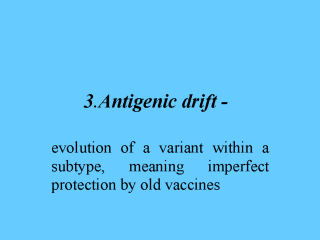| front |1 |2 |3 |4 |5 |6 |7 |8 |9 |10 |11 |12 |13 |14 |15 |16 |17 |18 |19 |review |
 |
Why? Each
H molecule carries 5 antigenic regions via which antibodies can HI, neutralize and block
attachment to host cells. A change in any region results in antigenic drift. The RNA genes
of influenza are constantly mutating, during error-prone replication. If the mutation
involves escape from neutralisation the variant is selected in infected animals. Drift is detected by 2-4-fold alterations in HI titres between one isolate and another isolate recovered several years later. Drift is now best assessed by panels of mAb in HI tests and nucleotide sequencing of the neutralisation sites on H. These mutations accumulate with time. The human viruses appear to accumulate more mutations than the equine, which may relate to the presence of more people than horses in the world. |